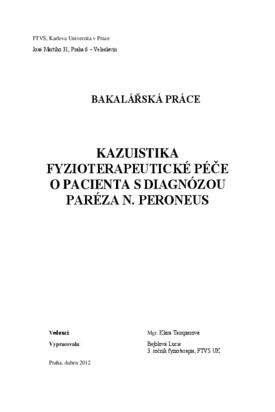Kazuistika fyzioterapeutické péče o pacienta s diagnózou paréza n. peroneus
Case study: Physiotherapy treatment of a patient with the diagnosis of paresis n. peronei
bachelor thesis (DEFENDED)

View/
Permanent link
http://hdl.handle.net/20.500.11956/46417Identifiers
Study Information System: 122039
Collections
- Kvalifikační práce [8840]
Author
Advisor
Referee
Marková, Bronislava
Faculty / Institute
Faculty of Physical Education and Sport
Discipline
Physiotherapy
Department
Information is unavailable
Date of defense
21. 5. 2012
Publisher
Univerzita Karlova, Fakulta tělesné výchovy a sportuLanguage
Czech
Grade
Good
Název: Kazuistika fyzioterapeutické péče o pacienta s parézou n. peroneus. Cíle: Získání teoretických a praktických znalostí o periferních parézách, zejména periferní parézy n. peroneus. Následné vypracování kazuistiky pacienta s vybranou diagnózou vytvořenou během konání souvislé odborné praxe. Metody: Obecná část bakalářské práce obsahuje teoretické poznatky o anatomii periferního nervového systému dolní končetiny, klinickém obrazu periferních paréz dolní končetiny a léčbě s následnou terapií. Výsledky: Snížení stupně zkrácení svalů zkrácených, zvýšení svalové síly oslabených svalů, zlepšení rozsahu kloubní pohyblivost, odstranění reflexních změn a obnova joint play. Závěr: Indikace fyzioterapie je jedním z nejdůležitějších faktorů při léčbě periferních paréz Klíčová slova: Periferní paréza, n.peroneus, fyzioterapie, kazuistika.
Title: Case study of physiotherapy treatment of patient with the paresis n. peroneus . Goals: Gain of theoretical and practical knowledge about peripheral paresis, especially peripheral paresis n. peroneus . Subsequent case study formulation of patient with selected diagnosis made during coherent scholarly practice. Methods: The theoretical part of this bachelor thesis contains theoretical knowledge about anatomy of peripheral nervous system of the lower extremities, the clinical image of the peripheral paresis ane the treatment with sequential therapy. Results: Decrease of muscle shortening. Increase of muscle strenght in weakened muscels, improvement of movement range, elimination of reflective changes and restoration of joint play. Conclusions: Indication of physiotherapy is on of the most important in the treatment of peripheral paresis. Key words: peripheral paresis, n.peroneus, physiotherapy, case study.
